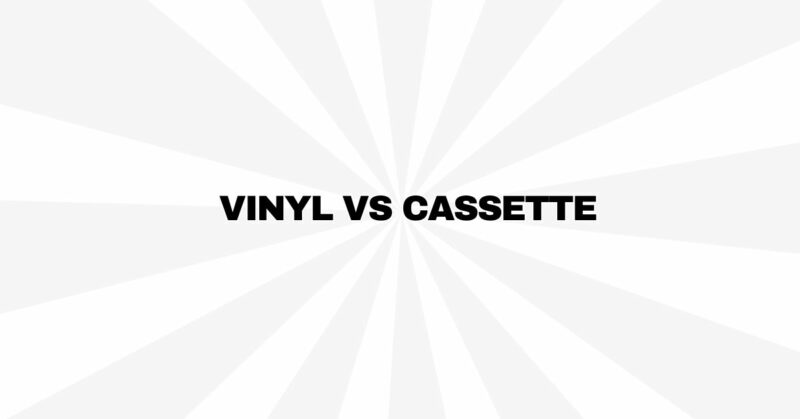In the world of analog audio formats, two contenders have endured the test of time: vinyl records and cassette tapes. Despite the digital revolution and the convenience of streaming music, both vinyl and cassette tapes maintain dedicated fan bases and continue to enjoy a resurgence in popularity. In this article, we’ll explore the unique qualities and characteristics of vinyl and cassette tapes, comparing them in terms of audio quality, nostalgia, collectibility, and the overall listening experience.
Audio Quality: Vinyl’s Analog Warmth vs. Cassette’s Nostalgic Hiss
One of the central debates when it comes to vinyl vs. cassette is audio quality. Each format has its distinct sound profile, and listeners’ preferences often hinge on these differences.
- Vinyl Records:
- Analog Warmth: Vinyl records are celebrated for their analog warmth. The music is physically etched onto the surface as grooves, providing a warm and organic sound that many audiophiles and music enthusiasts adore. The analog nature of vinyl is often credited with delivering a rich and immersive listening experience.
- Dynamic Range: Vinyl records typically offer a wide dynamic range, which means they can reproduce subtle nuances in music, making them particularly well-suited for genres like jazz and classical.
- Imperfections: Vinyl’s imperfections, such as surface noise, occasional pops, and clicks, are considered part of its charm by many enthusiasts. These imperfections can add character to the listening experience, similar to film grain in movies shot on celluloid.
- Cassette Tapes:
- Warmth and Hiss: Cassette tapes are known for their warm, sometimes lo-fi sound. They often introduce a gentle hiss and subtle warble, which some people find nostalgic and endearing. This warm and hissy quality is associated with the analog format and can be particularly appealing for certain genres.
- Portability: Cassettes offer a level of portability that vinyl records can’t match. Compact and easy to carry, cassettes were popular for on-the-go listening with portable cassette players, often referred to as “walkmans.”
- Mixtapes and Personalization: Cassettes were widely used for creating mixtapes, allowing listeners to curate and personalize their music collections. These homemade mixtapes hold sentimental value for many, adding to the appeal of cassette tapes.
Nostalgia and Sentimentality:
Nostalgia plays a significant role in the enduring popularity of both vinyl and cassette tapes.
- Vinyl Records: Vinyl’s nostalgia is often associated with the classic album format, with its large, visually appealing album covers and the act of carefully placing the needle on the record. Many music enthusiasts appreciate the tactile experience of vinyl, as it evokes memories of a time when music was a physical and interactive medium.
- Cassette Tapes: Cassettes evoke a sense of nostalgia for those who grew up in the 1980s and 1990s. Many people have fond memories of creating mixtapes, recording songs off the radio, and trading tapes with friends. The tactile experience of handling a cassette, flipping it over, and pressing play can transport individuals back to their youth.
Collectibility and Rarity:
Both vinyl and cassette tapes offer opportunities for collectors to hunt for rare and unique releases.
- Vinyl Records: Vinyl collectors often search for limited editions, special pressings, and colored vinyl variants. The vinyl community values the exclusivity and value of certain releases, making collecting vinyl records a rewarding pursuit.
- Cassette Tapes: Cassette collectors also enjoy the thrill of the hunt. Many tapes from the 1980s and 1990s have become sought-after collectibles. Additionally, independent musicians and labels continue to release music on cassette, contributing to the format’s collectibility.
Overall Listening Experience:
The listening experience for both vinyl and cassette tapes is deeply personal and subjective.
- Vinyl Records: Listening to vinyl records often involves an immersive experience. The ritual of selecting a record, handling it with care, and positioning the stylus on the groove creates a unique connection between the listener and the music. Many enthusiasts argue that the analog warmth and the physicality of vinyl enhance their appreciation of the music.
- Cassette Tapes: Cassette listening can be more casual and portable. The ability to create custom mixtapes allows for a personalized listening experience. For some, the hiss and warmth of cassettes contribute to a sense of nostalgia and authenticity, making them the preferred medium for certain types of music.
Conclusion:
The debate between vinyl and cassette tapes is a matter of personal preference and context. Both formats offer unique qualities and a range of listening experiences. Vinyl records are celebrated for their analog warmth, dynamic range, and tactile nature, while cassette tapes are cherished for their nostalgia, portability, and mixtape culture.
Ultimately, the choice between vinyl and cassettes comes down to individual taste, the type of music being enjoyed, and the emotional connections associated with each format. Both vinyl and cassette tapes have carved out a lasting place in the hearts of music enthusiasts, proving that analog formats continue to hold their own in the digital age.


